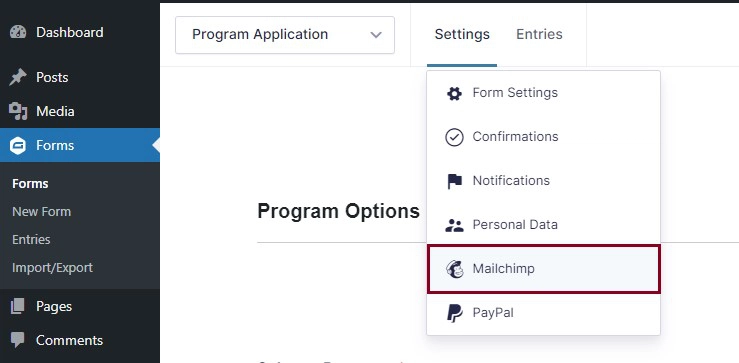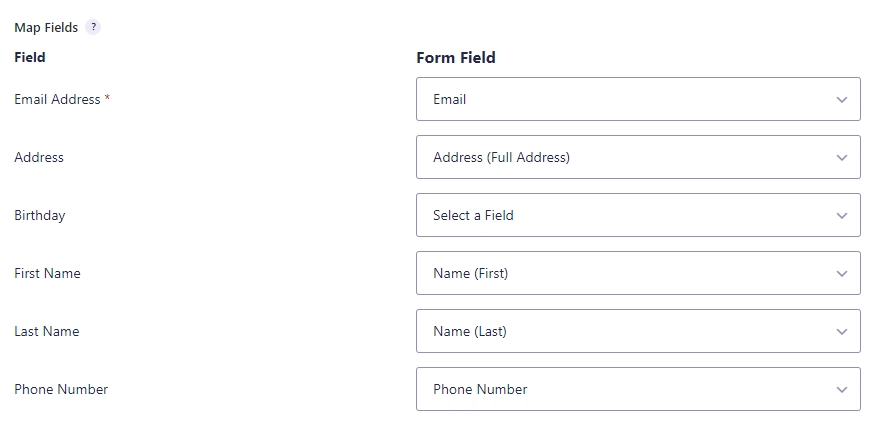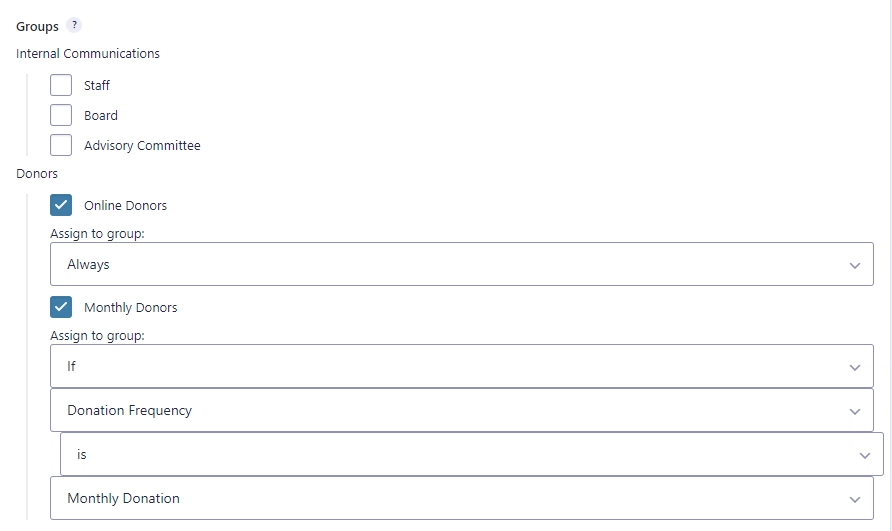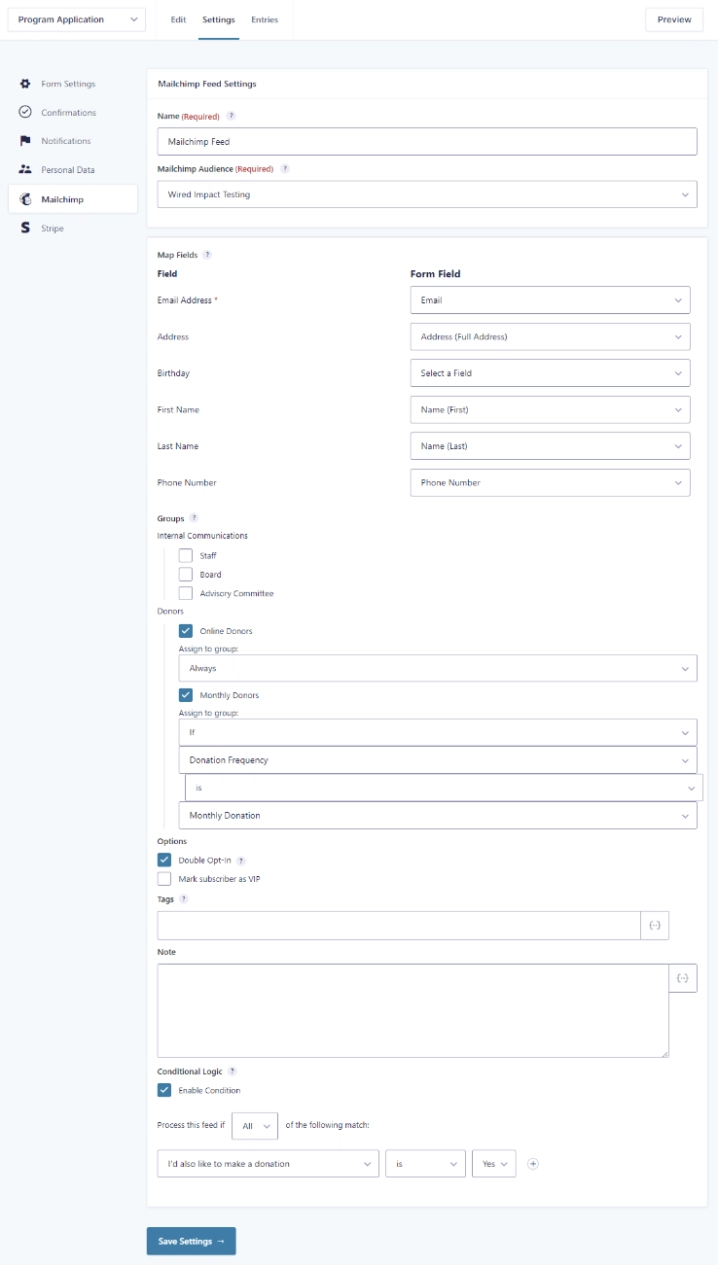Are you collecting email subscribers on your website using an online form? Use the steps below to connect your form with Mailchimp so you don’t have to manually add contact information each time a visitor submits your form. Instead, each time a visitor completes the form their submission information will be added to Mailchimp automatically.
FEATURE AVAILABILITY
The Form Builder is available for Grow and Amplify plan websites. Change your plan in the Account & Billing section of your website Dashboard.
Helpful Terminology
- The email provider refers to the service you use to send mass emails to your supporters. The most common providers are Mailchimp and Constant Contact, but there are many more.
- A feed on a form refers to that form’s connection with a third-party provider. For example, you would set up a feed to add a new donor to your provider’s email list automatically. This feed is typically processed each time a visitor submits your form.
- Conditional logic is used to determine the criteria in which a form’s feed is processed. For example, you may have an event registration form where visitors can opt to subscribe to your newsletter while registering for the event. The feed that adds subscribers to your email list would need to have conditional logic so that it only processes the feed when the visitor chooses to sign up.
If your organization uses an email provider that isn’t Mailchimp, learn how to connect to other services.
Set Up a Mailchimp Feed
- While editing your form, hover over the Settings menu and click Mailchimp in the dropdown.

- Click the Add New button to create a new feed.
- Enter a Name for the feed. You can set this name to something generic such as “MailChimp Feed”, or if you end up having multiple feeds that only run under specific circumstances, we’d recommend naming it something more descriptive. For example, on a form asking for contact information it’s possible the visitor provides both their personal and work email, then selects which is their preferred contact method. For this form you’d need two feeds, one to pass the work email address to MailChimp and another to pass the personal email address. In that case, you may want to name the feeds “Personal Email Preferred” and “Work Email Preferred” to make sure they’re clear.
- Choose the MailChimp Audience An audience serves to store and manage all of the contact data you receive.
- For Map Fields, select the fields on your form under the Form Field section to map them with the corresponding Mailchimp audience Field on the left. Try to map as many of your form fields as possible. If you’re missing one, such as the “Phone”, you can leave it set to “Select a Field”. Be careful to map the fields correctly. When you’re done, the information should look similar to this screenshot.

- Check the boxes for the Mailchimp Groups the visitor should be added to when they submit the form.
- If you’d like the visitor to be added to a group only under certain circumstances, choose “If” from the Assign to group dropdown. Then set the condition with which to add the visitor to that group. The settings shown below add the visitor to the “Monthly Donors” group only when the visitor chooses “Monthly Donation” for the “Donation Frequency” field. The visitor is always added to the “Online Donors” group.

- Under Options, check the box if you’d like to enable Double Opt-In for your form. This sends a confirmation email to the visitor with a link they must click to be subscribed to your Mailchimp audience. We recommend turning on double opt-in only if it’s the approach you’ve taken elsewhere. If you’re not sure, it may be helpful to check the Mailchimp feeds on your other forms.
- Under Options, check the box if you’d like to Mark subscriber as VIP. By marking a subscriber as a VIP, you can use segmenting conditions within Mailchimp to send them targeted campaigns.
- Enter a comma-separated list of any optional Tags you’d like to apply to the visitor. For example, if you wanted to add the “Influencer” and “Out of State” tags, you’d write it as “Influencer, Out of State”. You can also use the downward arrow on the right side of the field to tag a visitor with content they entered in a text box or their choice in a dropdown, checkbox or radio button.
- For example, you might want to tag a donor based on whether they donated one-time or monthly. You could choose the “Donation Frequency” field from the dropdown. The Tags content would then read something along the lines of “{Donation Frequency:20}”, and would tag the visitor with “One-Time Donation” or “Monthly Donation” depending on what the visitor selected for that field.
- Include a Note if you’d like one to exist in the visitor’s Mailchimp profile. This information would show in their activity feed in Mailchimp but would only be visible to you. Similar to tags, if you want to add content submitted within the form to your note, you can use the downward arrow on the right side of the field.
- If you’d like the feed to execute only under certain circumstances, check the box to enable Conditional Logic. The conditional logic shown below causes the feed to execute only when the visitor chooses “Yes” for the “I’d also like to make a donation” field.

Please note that you can modify the feed to add multiple conditions using the plus (+) icon on the far right and can also choose to execute the feed if “All” or “Any” of the conditions are true.
- Review your settings and click the blue Save Settings button to save your feed.
- If you need to add another feed to the same form, start over and follow these steps again until all the necessary feeds are created. For example, you may need to create two feeds that each send information into different Mailchimp audiences.
- Most importantly, please test your form including each feed to ensure they send information into Mailchimp as expected.
A Complete Mailchimp Feed Example
For reference, we’ve included a screenshot below of a completed Mailchimp feed. This feed adds the visitor to the “Wired Impact Testing” audience when the form is submitted.
Still Have Questions?
The quickest way to get support is to reach out to us within your website’s admin dashboard. Log into your website and then fill out the Request Help form. You’ll hear back from us within one business day.
